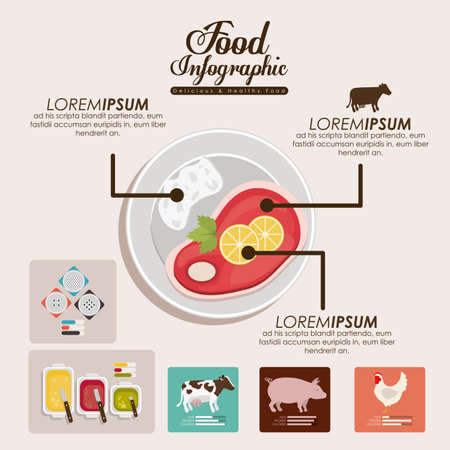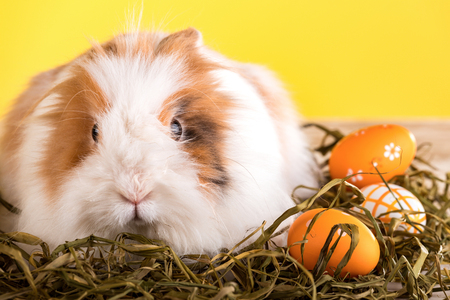1. Essential Nutrients for a Healthy Guinea Pig
Guinea pigs have specific dietary needs to stay healthy and active. Providing the right nutrients ensures they live a long and happy life. Below are the essential nutrients your guinea pig requires.
Vitamin C: A Crucial Nutrient
Unlike many other animals, guinea pigs cannot produce their own Vitamin C. This means they must get it from their diet. A lack of Vitamin C can lead to scurvy, which causes weakness, swollen joints, and loss of appetite.
Best Sources of Vitamin C:
- Bell peppers (red, yellow, green)
- Kale
- Parsley
- Oranges (in small amounts)
- Pellets fortified with Vitamin C
Fiber: Essential for Digestion
Guinea pigs need a fiber-rich diet to maintain a healthy digestive system. Fiber helps prevent gastrointestinal issues like bloating and diarrhea.
Best Sources of Fiber:
- Timothy hay (should be available at all times)
- Orchard grass
- Meadow hay
- Fresh vegetables like romaine lettuce and carrots (in moderation)
Proteins: Building Blocks for Growth
While guinea pigs don’t require as much protein as carnivorous animals, they still need a balanced amount to support muscle development and overall health.
Best Sources of Protein:
| Food Source | Protein Content |
|---|---|
| High-quality guinea pig pellets | 15-18% |
| Alfalfa hay (for young or pregnant guinea pigs only) | Higher in protein than Timothy hay |
| Leafy greens (spinach, kale in moderation) | Low but beneficial |
Water: The Most Important Nutrient
A fresh supply of clean water is critical for your guinea pigs health. Always provide fresh water in a sturdy water bottle with a sipper tube to prevent contamination.
Tips for Providing Water:
- Change the water daily to keep it fresh.
- Avoid sugary drinks or flavored waters.
- If using tap water, ensure its free from harmful chemicals like chlorine.
A well-balanced diet rich in Vitamin C, fiber, protein, and fresh water will keep your guinea pig happy and healthy. In the next section, we’ll discuss the best types of food to include in their daily meals.
2. Best Foods for Your Guinea Pig
Providing a balanced diet is essential to keeping your guinea pig happy and healthy. Their diet should primarily consist of fresh hay, leafy greens, and high-quality pellets. Below, we explore the best foods to include in your guinea pig’s daily meals.
Fresh Hay: The Most Important Food
Hay is the staple of a guinea pig’s diet and should be available at all times. It provides essential fiber that supports digestion and helps maintain dental health. Timothy hay is the best choice for adult guinea pigs, while young or pregnant guinea pigs may benefit from alfalfa hay due to its higher calcium content.
Leafy Greens and Vegetables
Fresh vegetables provide essential vitamins and nutrients for your guinea pig. Leafy greens should be included daily, while other vegetables can be given in moderation.
| Type | Examples | Frequency |
|---|---|---|
| Leafy Greens | Romaine lettuce, cilantro, parsley, kale (in moderation) | Daily |
| Other Vegetables | Bell peppers, carrots, cucumbers, zucchini | A few times per week |
| Avoid | Onions, garlic, potatoes, iceberg lettuce | N/A (Toxic or unhealthy) |
High-Quality Pellets
Pellets specially formulated for guinea pigs provide additional nutrients, including vitamin C. Choose plain, high-fiber pellets without added seeds or artificial ingredients. Feed about 1/8 cup per day alongside fresh hay and vegetables.
Fresh Fruits as Occasional Treats
Fruits are high in sugar and should only be given as occasional treats. Some safe options include apples (without seeds), strawberries, blueberries, and oranges. Limit fruit intake to small portions a couple of times a week.
Water: Essential for Hydration
Your guinea pig should always have access to fresh, clean water in a sturdy water bottle or bowl. Check and refill it daily to ensure proper hydration.

3. Foods to Avoid
While guinea pigs enjoy a variety of fresh foods, some items can be harmful or even toxic to them. To keep your pet safe and healthy, it’s essential to know which foods should be avoided.
Dangerous Foods for Guinea Pigs
Certain foods can cause digestive issues, toxicity, or other health problems for guinea pigs. Here are some of the most dangerous foods:
| Food | Reason to Avoid |
|---|---|
| Chocolate | Contains theobromine, which is toxic to guinea pigs. |
| Onions & Garlic | Can cause digestive upset and damage red blood cells. |
| Dairy Products | Guinea pigs are lactose intolerant and cannot digest dairy. |
| Potatoes & Potato Peels | Contain solanine, a toxic compound for guinea pigs. |
| Nuts & Seeds | Tough to digest and can pose a choking hazard. |
| Mushrooms | Certain varieties can be toxic and hard to digest. |
| Icy or Frozen Foods | Can cause digestive shock and discomfort. |
| Bread & Processed Foods | Lack nutritional value and can lead to obesity. |
Avoid Toxic Plants and Garden Greens
If you allow your guinea pig time outside, make sure they don’t nibble on plants that could be poisonous. Common toxic plants include lilies, ivy, daffodils, and tulips. Always supervise their outdoor time to prevent accidental ingestion of harmful plants.
No Sugary or Salty Snacks
Treats like candy, chips, or sugary cereals should never be given to guinea pigs. Their digestive systems aren’t built for processed foods, and too much sugar or salt can lead to serious health issues.
The Importance of a Safe Diet
A well-balanced diet is key to keeping your guinea pig happy and healthy. By avoiding these dangerous foods, you help ensure your pet lives a long and thriving life. Always double-check before introducing any new food into their diet!
4. Feeding Schedule and Portion Control
Understanding how often and how much to feed your guinea pig is essential for maintaining a healthy weight and preventing obesity. Guinea pigs have sensitive digestive systems, so providing a balanced diet at the right intervals is key to their well-being.
How Often Should You Feed Your Guinea Pig?
Guinea pigs should have continuous access to fresh hay, as it helps with digestion and keeps their teeth in good condition. In addition to hay, they need daily servings of fresh vegetables and a controlled portion of pellets.
Recommended Daily Feeding Schedule
| Food Type | Feeding Frequency | Portion Size |
|---|---|---|
| Timothy Hay | Available at all times | Unlimited |
| Pellets | Once per day | 1/8 cup (per adult guinea pig) |
| Fresh Vegetables | Once or twice per day | 1 cup (variety of leafy greens and veggies) |
| Fresh Fruits | A few times per week | A small slice (as a treat only) |
| Clean Water | Available at all times | Unlimited (refresh daily) |
Portion Control Tips
- Avoid overfeeding pellets: Too many pellets can lead to obesity. Stick to the recommended portion size.
- BALANCE vegetable intake: Provide a mix of vitamin C-rich vegetables like bell peppers and dark leafy greens.
- Treat fruits as an occasional snack: Fruits are high in sugar, so offer them sparingly.
- Mornings and evenings work best: Splitting fresh veggies into two meals can help mimic their natural grazing habits.
The Importance of Consistency
Your guinea pig thrives on routine, so try to feed them at the same time every day. This helps regulate their digestion and keeps them happy and healthy.
5. Hydration and Supplemental Treats
Ensuring your guinea pig stays hydrated is just as important as providing the right food. Water plays a vital role in digestion, temperature regulation, and overall health. Along with fresh water, occasional treats can be given to add variety to their diet while keeping them happy and healthy.
Providing Clean and Fresh Water
Your guinea pig should always have access to clean, fresh water. The best way to provide water is through a water bottle with a sipper tube, as it helps prevent contamination from bedding or food particles. A small, heavy bowl can also be used but requires frequent cleaning to avoid spills and bacterial growth.
How Often Should You Change the Water?
- Change the water daily to keep it fresh.
- Clean the water bottle or bowl at least once a week with warm, soapy water.
- Check for any clogs in the sipper tube to ensure proper water flow.
Safe Treats for Your Guinea Pig
Treats can be a great way to bond with your guinea pig, but they should only be given occasionally. Too many sugary or starchy foods can lead to obesity and digestive issues. Here are some safe treat options:
| Treat | How Often? | Benefits |
|---|---|---|
| Small pieces of bell pepper | A few times per week | Rich in Vitamin C |
| Cucumber slices | A few times per week | Hydrating and refreshing |
| A small piece of apple (without seeds) | Once a week | Naturally sweet but should be limited due to sugar content |
| A tiny portion of carrot | A couple of times per week | A good source of beta-carotene but high in sugar |
| Dandelion leaves (from pesticide-free areas) | A few times per week | Packed with nutrients and fiber |
Treats to Avoid
Certain foods can be harmful to guinea pigs and should never be given as treats:
- Dairy products – Guinea pigs are lactose intolerant.
- Nuts and seeds – These can be choking hazards and are too fatty.
- Bread, crackers, or processed foods – These lack nutritional value and can cause digestive problems.
- Sugary fruits like bananas or grapes – Can contribute to obesity if fed too often.
- Onions, garlic, potatoes – These are toxic to guinea pigs.
The Right Balance Between Food, Water, and Treats
Your guinea pig’s diet should primarily consist of hay, fresh vegetables, and fortified pellets. Treats should only make up a small part of their diet. Always monitor their reaction when introducing new foods, ensuring they tolerate them well without any digestive issues.
A well-hydrated guinea pig with an occasional healthy treat will stay happy and active. Keep up with their dietary needs, and you’ll have a thriving little companion!

